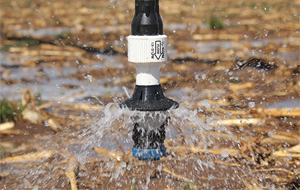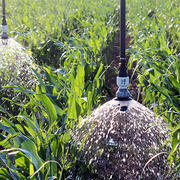
In the mid 80’s Senninger worked with researchers at the Texas A&M AgriLife Research & Extension Center to release the first Low Energy Precision Application (LEPA) sprinkler.
This technology was developed for center pivot irrigators in the western high plains of the United States who were affected by high energy costs and declining water availability due to dropping water tables or dwindling surface supplies.
LEPA systems use low-pressure bubbler heads to deposit water directly into furrows just 8 to 18 inches above the ground. With the heads closer to the ground, the water avoids the hitting leaves, so it does not come in contact with plants and fruit susceptible to water-borne diseases and nearly all of it is absorbed by the soil.
In fact, researchers and growers have found that with these low pressure heads, at least 20 percent more water reaches the soil compared with conventional spray nozzles.
What began 30 years ago as LEPA has evolved into one of the most effective irrigation methods known today for center pivot systems ‒ close spacing. Close spacing has been a proven success in many dry regions across the US. It is an irrigation method based on LEPA that is gaining ground in areas where water is regulated and people are increasingly concerned about diminishing natural resources.
The reason why close spacing irrigation is gaining popularity among growers in America is simple ‒ growers are saving water, saving energy, and seeing increased yields.
Furthermore, this high-performance technology works at low pressures, which makes it ideal for reducing energy and pumping costs, as well.
A Closer Look
Close spacing combines the use of the same water-efficient LEPA bubbler heads with conservation tillage. Just as in those LEPA applications, close spacing heads are mounted 8 to 18 inches above the soil to combat wind-drift and prevent evaporation losses. Both methods require nearly identical management practices and provide similar benefits.
Close spacing started to take shape among North Texas growers who experimented with combining LEPA technology with conservation tillage, and began placing bubbler heads on every row. In traditional LEPA systems, sprinklers are placed 60 inches apart to irrigate every other furrow. The close spacing method, with 30 inches between heads, distributes water over most of the soil surface.
The crop residues left over from previous growing seasons helps prevent evaporation loss and run-off and holds the water until the soil is ready to soak it in. As a result, close spacing technology achieves application efficiencies typically exceeding 95 percent.
Making It Work
Success with close spacing depends on three key factors: the right irrigation equipment, the right farming practices and the right field conditions.
Senninger bubblers made for LEPA have proven to be the ideal sprinklers for getting the most out of close spacing irrigation. They operate at low pressures ranging from 6 to 20 PSI, using less energy than conventional low-pressure sprinklers, and operate using fewer gallons per minute than conventional spray nozzles ‒ approximately 0.27 to 21.18 gpm.
There are two types of bubbler sprinklers currently available. One creates a narrow, aerated stream of bubbling water that resists high temperatures and strong winds. This sprinkler deposits water directly into furrows, which avoids wetting the foliage.
The other deflects water down in a wide, dome-shaped pattern that gently delivers the water without spraying, which is ideal for germination, low crop watering and sensitive soils that are prone to compaction. Due to its less concentrated distribution pattern, it can be used on fields without furrows and on some rolling terrains.
Because close spacing sprinklers are mounted 8 to 18 inches above the ground, this method works better on relatively flat farms. The maximum recommended slope for fields considering close spacing is one percent. Circle planting allows bubblers to be centered in furrows, which is ideal for further controlling run-off. It is used by growers who also want to prevent wetting the crop canopy when taking advantage of close spacing applications.
The versatility of bubbler sprinklers provides the opportunity to combine various components to suit different crop and soil needs. Some growers, for example, combine conventional spray heads with bubble applications at various crop stages. Others alter the spacing on the first few spans, vary the sprinkler height off the ground, and even alter the application rate by irrigation cycle.
Source
Published as "Save Water, Increase Yields with Close Spacing". Groundwater Foundation's Blog. July 2016.


